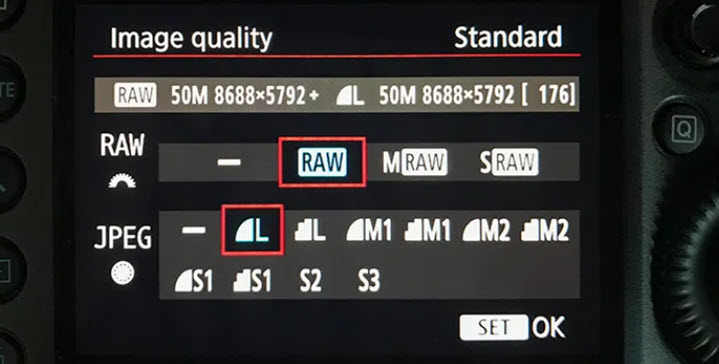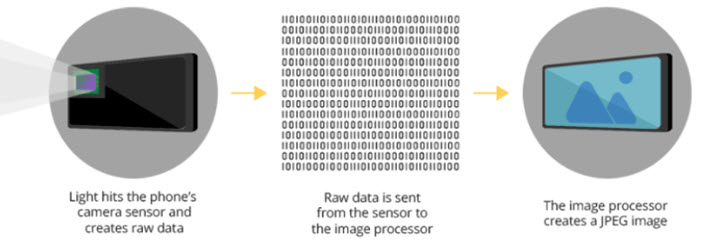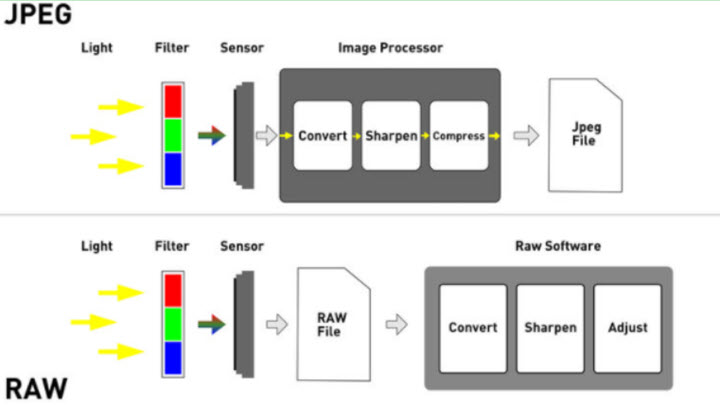Shooting in RAW can be intimidating for novices. Picturing yourself sitting in front of complicated software, dragging the curves and dialing the sliders can be overwhelming. Given the maximum control and other benefits, it is still worth trying shooting in RAW.

In this article, we will go through the concept of RAW image (it is actually not an image), illustrated from the starting point when you hit the shutter button. Then there's a comparison between RAW vs JPEG, which may help to eliminate some misunderstanding about RAW, and brings about the pros and cons of shooting in RAW.
What Is RAW Image
A RAW image file is a record of all the information recorded from the camera's sensor. It can be better understood if we review the process, from the moment you take the photo to the time you see that image on the camera screen.
When you press the shutter, light hits the sensor of your camera, creating data and information, which is the RAW we are talking about. The data is then sent to the image processor, being interpreted into a JPEG thumbnail, so that you can see it on the screen.

That JPEG image is only used for the purpose of previewing, while the RAW file stays untouched, preserving all the information when the light hits the sensor.
An analogy of turning the negative film into a photo would help explain the idea. When the light hits the plastic film (RAW), it records all the information of the scene you are taking. Following several procedures (the conversion process) in the darkroom, you can then develop it into a photo (JPEG straight out of the camera, or the output image in post production).
In fact, DNG (Digital Negative Graphics), Adobe's raw image format, gets its name from this analogy.
When you shoot in RAW, the data about the image is untouched. You can decide how to interpret the information in post production, such as editing the RAW in Lightroom or other capable software.
When you don't shoot in RAW, the camera takes over the decision-making, and converts the RAW into JPEG directly in-camera. How the RAW file is "developed" can be varied among different camera manufacturers.
RAW vs JPEG
Why shoot RAW over JPEG? Or when to do it the other way around? Here is a quick comparison of RAW vs JPEG.

Amount of Information
- RAW keeps all the information and data unprocessed and uncompressed. The RAW image file is not truly an image that you can look at visually.
- JPEG is the result of the data interpreted and compressed, undergoing processes such as demosaicing, deciding white balance, applying gamma correction, setting color saturation, contrast, sharpening, etc. As a result, it contains less amount of data, since each process can affect the information contained in the pixel.
Shades of Color
- A standard JPEG has a bit depth of 8-bit, that is 256 levels (2 to the power of 8 equals 256).
- A RAW image file can be 12-bit, 14-bit, 16-bit, etc, and that equals 4096, 16384 and 65536 levels of colors and tones.
The Nitty-Gritty About RGB
An RGB representation of the color is (R, G, B), with the value being 0 to 255 in 8-bit and 0 to 4095 in 10-bit.
So the shades of green can be anything between (0,1,0) to (0, 255, 0) in 8-bit, and (0,1,0) to (0, 4095, 0) in 10-bit.
Consider the situation where you take a photo of trees, the 12-bit color allows for more subtle shades of the color green than that of the 8-bit.
White Balance Adjustments
- With RAW, the white balance setting is not "baked" into the image file, meaning it contains all the information needed to adjust later on.
- With JPEG, the white balance has already been processed according to your in-camera white balance settings.
The difference is shown when you edit the image in Lightroom or similar applications. For the JPEG image, the parameters for white balance, Temp and Tint are relative numbers.

While for the RAW file, they are absolute values.

The JPEG file doesn't offer extended data for the software to refer to and draw on, so the white balance adjustment starts at how the JPEG file already looks like.
In theory, this difference implies that RAW image allows for cleaner shadows and finer contrast. Though, in practice, they might look similar to the untrained eye.
Dynamic Range
- A RAW file offers relatively more dynamic range possibilities in post-editing.
- A JPEG file has already gone through the conversion process in-camera, losing some data.
When shooting in RAW, the process to convert the exposure information, the amount of light, into logarithmic values is deferred. In post-editing, you can flexibly adjust the exposure, by dialing up 1 stop, or minus 1 stop, for instance. When combined, there is a broader range of highlight and shadow details, without banding.
Sharpness and Noise Adjustments
To make it clear, the sharpness here doesn't refer to the artistical concern, or the solution to fix a blurry photo due to an error in shooting.
The sharpening here refers to the inherent process after the processor assembles the image from the sensor. JPEG goes through that process, while for RAW, the sharpening is deferred in the post.
Such a difference entails that:
- A RAW file allows for more options. You can decide how the sharpness is applied to compensate for the inherent softness, in much more powerful applications on a computer.
- A JPEG file has already gone through the sharpening process in-camera, taking whatever is set as the onboard algorithm inside the camera's processor.
Since the sharpening for JPEG is already done in-camera, you won't be able to recover the details lost in noise reduction, or mitigate artifacts brought about by the onboard sharpening algorithm. For RAW, you can decide how the sharpening is applied to the image in dedicated software such as Photoshop and Lightroom.
Destructive vs Non-destructive
As you can see from the brief analysis above, the changes made to JPEG are destructive, in terms of the data lost during the processing in-camera. RAW file defers that process, and the changes are in the metadata, instead of the original data.
When you shoot in RAW, and preview it on the camera screen, you are actually looking at a JPEG version created based on the metadata. The original data is still untouched, and can be later processed on a computer, and edited into any other version of JPEG, PNG, etc.
Benefits When Shooting in RAW
From the above analysis, you can see there are indeed many benefits for photographers to shoot in RAW.
1. Being non-destructive means you can play around and edit the photo to your liking, whether now or in the future, without worrying about certain artifacts that are unavoidable when shooting in JPEG.
2. Since RAW contains all the information, you can choose color space in post-editing, and manipulate more parameters such as exposure levels, white balance, saturation, hue, and sharpness.
3. You can bypass undesired settings in a camera that are intended for JPEG processing. Such as white balancing, sharpening, and noise reduction, which is irreversible once adjusted.
4. You can rely on a more powerful processor built-in advanced software on a computer, than make do with the camera's processor. Thus using different algorithms for processes such as demosaicing, or the unsharp mask for sharpening.
5. You can tap on the 12-bit or higher bit depth, and choose your gamma curve later on. The larger amount of levels guarantees a continuous gradation of color tones — at least as how human eyes perceive it, even though the digital colors are encoded in discrete integers — while the 8-bit compressed JPEG is vulnerable to color banding and accidental posterization.
6. Exerting a per-image evaluation is also a plus. Since the RAW is still in the linear space and has yet applied a gamma curve, and that calculation has not been done, you have much room in the post to adjust each photo for a specific need. For JPEG, you have to stick to those generalized settings for all photos taken.
When You Don't Want to Shoot in RAW
One person's meat is another's poison. RAW may not be suitable for all photographers under various situations.
1. It adds time to your workflow, while the outcome may be less discernible.
Since RAW is not viewable, you need to edit every RAW image file on a computer, and save it to formats such as JPEG or PNG for sharing.
For a non-demanding scene or content, the outcome of editing a RAW file versus the JPEG that is straight out of the camera may be similar, or the nuances are only noticeable on large screens or for the trained eyes.
That said, some cameras do have the option to take a RAW and generate a JPEG simultaneously. If you prefer the maximum control later on, while needing an immediate final version to share, this RAW+JPEG option can be a bridge solution.
2. RAW files are much larger than JPEG since it keeps all the original information intact.
Some data are redundant in RAW, with luminance and color information that makes no difference for the human visual system. With all the data occupying a significant amount of the storage space on the memory card, you can take fewer photos with the camera. Though the storage space is quite inexpensive these days, having to swap the memory card is still annoying, especially in a busy situation.
3. RAW allows for less Frame Rate than shooting JPEG or other representations.
If a higher frame rate is your aim, for instance when you are shooting for a time-lapse project, action sports, or in want of photo bursts, shooting in RAW can be problematic. It takes time for the processor to write the information into the memory card.
According to diyphotography, it takes 350 shots of JPEG before it hits the limit of the buffer, while for RAW, it's only 100 frames; and its 14 FPS for JPEG and 10 FPS for RAW.
4. It requires the photographer to have some knowledge in post-editing, and that can be a steep learning curve sometimes.
For the novices, edited RAW may not be as good as using the JPEG created by the camera. For instance, some photographers complain that an edited RAW image file comes less sharp than a JPEG straight out of the camera, and start to question the quality of RAW images.
When correctly done in post-editing, using an unsharp mask and adjusting radius, you can achieve desired sharpness with a RAW file. The problem is, some photographers may over process it, which leads to an unnatural "digital" look.
RAW Image Extension and Its Manufacturer
As you already know, RAW is not an extension format as in the sense of .jpg for JPEG, .png for PNG, .heic that holds HEIF (High Efficiency Image Format) images.
When people talk about RAW format, they can be referring to the concept of RAW, which can be simply understood as a record of the data created and stored without any further processing. When they talk about RAW format, it is not in the sense that RAW is an image format. To be more precise, the misleading RAW format is more about the way each camera manufacturer deals with their RAW data.
Camera manufacturers have their own proprietary file format to store the RAW data, below is a list of RAW extensions from different manufacturers or systems.
| Manufacturer/System | Extension | Note |
|---|---|---|
ARRI |
.ARI | ARRIRAW image |
Canon |
.CRW .CR2 .CR3 |
Canon RAW .CRW, CIFF-based (Canon Camera Image File Format) Canon Raw v2, CR2, TIFF-based Canon Raw v3, CR3, QuickTime-based |
Nikon |
.NRW .NEF |
Nikon Electronic Format TIFF/EP-based |
Sony |
.SRF .SR2 .ARW | ARW stands for Sony Alpha Raw SRF (Sony Raw Format) and SR2 are obsolete now |
Panasonic |
.RW2 | Also known as Leica RAW or RWL for certain Panasonic and Leica digital cameras. |
Fuji |
.RAF | / |
Minolta |
.MRW | TIFF/EXIF-based (but not fully compliant with TIFF) |
Hasselblad |
.3FR .FFF | TIFF-based |
Kodak |
.DCR, .K25, .KDC | TIFF-based |
Pentax |
.PEF | TIFF-based |
Olympus |
.ORF | / |
Ricoh |
.J6I | / |
Adobe Systems |
.DNG | TIFF/EP-based Supported in Android smartphones, iPhone, Leica, Samsung, Ricoh, Pentax, Hasselblad, etc. |
Over to You
Hope you have a better understanding of the RAW file, and what it means to shoot in RAW. This "digital negative" could be intimidating at first sight, but as you go through the process to shoot and edit it in the post, you will love the flexibility and degree of control it supports for color correction and color grading.







